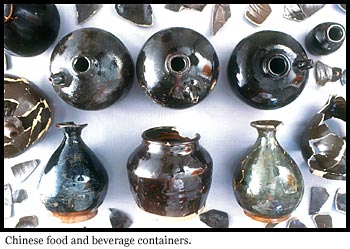

 There is conclusive evidence, from both historical documents and the recovered artifacts, to support the idea that the people living at this site laundered clothing as part of their occupation. A wooden porch was found adjacent to a brick-lined doorway (with a doorknob found on either side of it) that had a mass of over one thousand buttons scattered over its surface.
There is conclusive evidence, from both historical documents and the recovered artifacts, to support the idea that the people living at this site laundered clothing as part of their occupation. A wooden porch was found adjacent to a brick-lined doorway (with a doorknob found on either side of it) that had a mass of over one thousand buttons scattered over its surface.
Also telling was the recovery of a large number of a particular type of bitters bottle that contained a bright blue powder that must have been used for cleaning or bleaching
clothing.
 This exact type of bitters bottle was found at a laundry site in El Paso, Texas, with paper labels affixed to them written in Chinese advertising a cleaning fluid. This type of bottle reuse was not uncommon during the 19th century when glass containers were relatively expensive. All of these bottles exhibit slight imperfections in their embossing, which lends further support to the idea that they did not contain bitters at all, rather were sold wholesale to a Chinese laundry detergent manufacturer who filled and distributed them to the community of Chinese laundrymen throughout the United States. This important piece of corroborating evidence links the people living at the tiny site at Rich Sorro Commons to a very broad Chinese community.
This exact type of bitters bottle was found at a laundry site in El Paso, Texas, with paper labels affixed to them written in Chinese advertising a cleaning fluid. This type of bottle reuse was not uncommon during the 19th century when glass containers were relatively expensive. All of these bottles exhibit slight imperfections in their embossing, which lends further support to the idea that they did not contain bitters at all, rather were sold wholesale to a Chinese laundry detergent manufacturer who filled and distributed them to the community of Chinese laundrymen throughout the United States. This important piece of corroborating evidence links the people living at the tiny site at Rich Sorro Commons to a very broad Chinese community.
 The number of ceramic bowls, spoons and cups found in the small building is far more than a small group of people would need, suggesting that the people living in the building were providing hot meals to the larger community. The large number of food remains and food storage jars supports this idea. Also, most of the recovered faunal remains were pig bones, appearing to consist of the whole carcass of the animal in many cases. Roast whole adult and suckling pig is common fare in Chinese cuisine, therefore the recovered faunal remains seem to support the idea that the Wing Lee Laundry site also served as an informal restaurant-type establishment, offering traditional Chinese cuisine and recreation, for the community of Chinese immigrants living in the Steamboat Point/South Beach area during the mid-to-late 19th century.
Next ->
The number of ceramic bowls, spoons and cups found in the small building is far more than a small group of people would need, suggesting that the people living in the building were providing hot meals to the larger community. The large number of food remains and food storage jars supports this idea. Also, most of the recovered faunal remains were pig bones, appearing to consist of the whole carcass of the animal in many cases. Roast whole adult and suckling pig is common fare in Chinese cuisine, therefore the recovered faunal remains seem to support the idea that the Wing Lee Laundry site also served as an informal restaurant-type establishment, offering traditional Chinese cuisine and recreation, for the community of Chinese immigrants living in the Steamboat Point/South Beach area during the mid-to-late 19th century.
Next ->